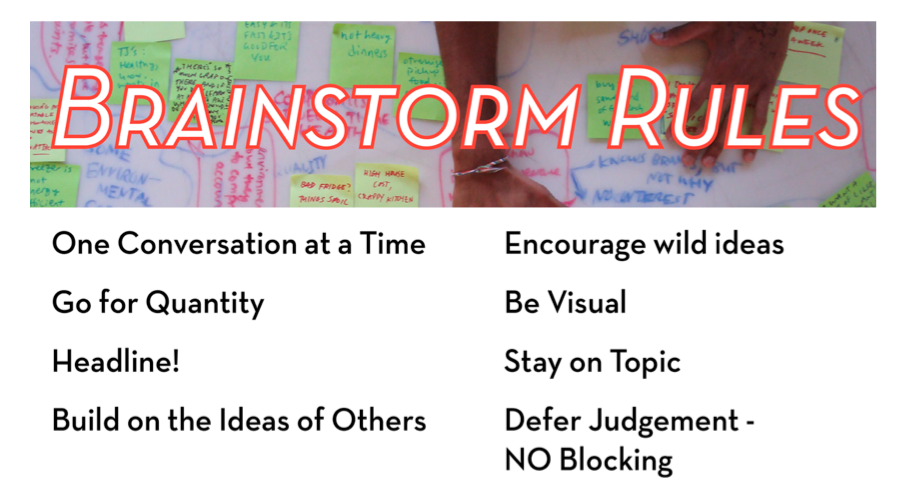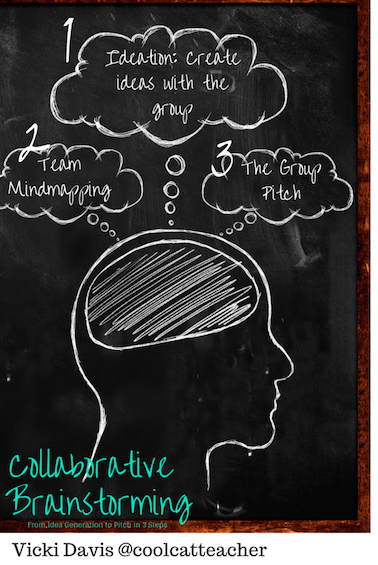Facilitating an effective brainstorming session with your students or colleagues can be difficult. As the facilitator, it is your role to keep the energy levels high and ensure that all participants are fully engaged. I created this post as a resource that you can share with your brainstorming session participants in order to highlight examples of how to effectively brainstorm, as well as expectations. Feel free to share and comment at the bottom of this page with feedback!
Brainstorming ideas for a short film #filmmaking #screenwriting
http://t.co/gd3q2nIn8L pic.twitter.com/Dp8fizfU9t
— Darious J. Britt (@D4Darious) June 3, 2015Brainstorming expecations for success
The purpose of a brainstorming sesion is to generate a large quantity of ideas. In order to do this, it's important to ensure that all group members are engaged in the brainstorming process. However, it's equally vital to create a warm and fun environment with your team. Here are some easy guidelines to ensure that your brainstorming team works effectively together:
- Draw or write out your ideas fast. Get the ideas out of your head as quickly as possible.
- Don't judge your ideas or the ideas of others. This part will come later when you narrow down your ideas to your best ones. Phrases like "this will never work" aren't allowed in brainstorming.
- Piggyback off the ideas of your teammates. Two brains are better than one and can have totally different perspectives on a concept. The more perspectives the better!
- Encourage wild ideas. The wilder the better! Stretch your thinking in your brainstorm to go way outside of the box.
Examples of productive and professional brainstorming sessions
Collaborative lesson brainstorming is happening w/ art materials in @PhillipsMuseum art workshop! #TeachwithPrismK12 pic.twitter.com/QDkwEMnSMO
— Prism.K12 (@PrismK12) May 20, 2015Collaboration is key! As you can see, all group participants are actively involved in an effective brainstorming session. You'll also notice that this group is getting really creative by brainstorming visually with paints. Brainstorming can take many different forms. Your group should choose to brainstorm ideas in a format that works the best for you.
Supporting each other & brainstorming with the HoCo ladies @HerCorner group over cake n wine. #bizwomen pic.twitter.com/qoFXUR0wYN
— Mary Gardella (@marygardella) May 20, 2015In this brainstorming example you can see that brainstorming participants are interacting with one another in a polite manner. Keep your brainstorming session fun by respecting others. Here are some sentence starters that can help to facilitate a collaborative brainstorming environment:
- Could you tell me more about the idea you're working on?
- That's a really cool idea. Is it ok if I also work on the same concept in a different way?
- I'd love to get your feedback on this concept. What do you think?
Examples of how your brainstorming document might look
Brainstorming is an inherently creative process. Feel free to get your ideas out in the way that works best for you and your team. Here are some examples:
- Post-it notes
- Drawings
- Digital documents (like a Google Doc or using Adobe Draw)
- Mindmaps
- Lists
Brainstorming Pit-Soul Style #pitchlikeagirl #SWGirls @LWGMS pic.twitter.com/ESvudPUzil
— Liz Hunt (@hilntuz) May 16, 2015As you can see in the image above, brainstorming could take the form of writing on a whiteboard, or working collaboratively on a document on the computer. You know how you work best and it's important to have the flexibility to capture your ideas during a brainstorm in a way that works best for you.
Passionate use of Popplet MT @3rdGrLDRS: Lots of GREAT synergizing, brainstorming for passion projects using Popplet pic.twitter.com/bZbB86Xwln
— popplet (@poppletny) May 26, 2015Mindmapping is another great way to organize your brainstorm. There are tons of awesome mindmapping apps and online tools that you can use for team members who prefer working digitally.
There’s a major brainstorming session underway at M A C K E E N E. #WorkspaceWednesday photo via @MACKEENE_ pic.twitter.com/4hgfNeuRMJ
— PANTONE (@pantone) May 13, 2015Sometimes brainstorming can be messy and that's ok. In the image above, the designer has spread out tons of Pantone colors to aid in his creative process. If your brainstorming session gets messy, that's fine---just remember to clean up afterwards.
How to select your best ideas from your brainstorm
During the brainstorm you weren't judging the ideas, right? Well, now it's time to let all of that judgment out. After an effective brainstorm you will have tons of ideas and some of them will inevitably be more interesting than others. Now, you'll need to discuss your ideas with your team. Here are some guidelines to facilitate that process:
- Explain your ideas succinctly and in an easily digestible manner. It's important for your team to understand your concepts
- Listen attentively to others. It's important for you to understand your teammates' ideas, too!
- Speak in turn. Don't interrupt others when they're explaining their ideas. The same applies vice vera. If someone interrupts you, politely let them know that you're not finished and continue.
-
Brainstorming character traits with @ChichesterFYT puppeteers for the animals in #RunningWild @ChichesterFT pic.twitter.com/O7eimRIcOF
— Gyre & Gimble (@GyrAndGmbl) May 25, 2015As you can see above, this student has taken his time to brainstorm a bunch of different ideas on two large sheets of paper. Now, he's going back over his ideas with a different colored pen, and highlighting his favorites. Don't limit yourself by choosing the easiest or most feasible ideas.It's important after a brainstorming session to narrow down your ideas to the most innovative and interesting ones. These will make the most interesting projects.
Ok so I was brainstorming other logo options even though I do like the skull. I tried fam @5SOS #WeWantTheTallyBack pic.twitter.com/IwVLtWhxPa
— bea • 52 days (@beasknee) May 10, 2015In the example above, you can see that this brainstorm produced some awesome logo ideas. Now, the group will professionally discuss the pros and cons of each design and work together to select the best design.
Residents brainstorm about core neighbourhood rec centre http://t.co/ITTlMJSjjV What would you like to see? #yxe pic.twitter.com/bdgHEf02zl
— Leisha Grebinski (@LeishaCBC) May 13, 2015You don't always have to sit down during brainstorming sessions. Brainstorming can be an active process using posters on the wall that allows team members to walk around the room.
Additional resources for brainstorming
Check out the Stanford d.School resource on brainstorming.

Brainstorming Rules by the Stanford dSchool
Cool Cat Teacher, Vicky Davis, also has an awesome resource on a 3-step brainstorming process. Check it out here!

Cool Cat Teacher's 3 Step Brainstorming Process
How do you facilitate brainstorming sessions in your classes?
Comment below to share your experiences with facilitating brainstorming sessions. I'd love to hear your ideas!